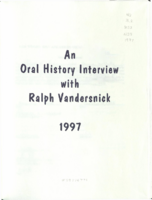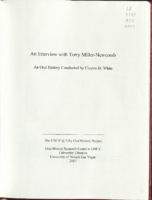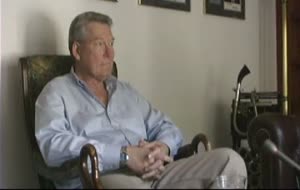Search the Special Collections and Archives Portal
Search Results

Transcript of interview with Ralph Vandersnick by Dennis McBride, October 18, 1997
Date
Archival Collection
Description
Ralph Vandersnick was interviewed on October 18, 1997. Ralph owns Snick's Place, the longest-operating gay bar in Las Vegas and whether he'd agree or not, he's one of the most respected members of the Las Vegas gay community.
Text

Transcript of interview with Aaron Williams by Claytee D. White, August 16, 2005
Date
Archival Collection
Description
Aaron Williams moved to Las Vegas in 1960 and worked at the Nevada Test Site before serving as North Las Vegas councilman, County Commissioner and community activist. Williams sponsored youth baseball teams in North Las Vegas.
Text
#64659: Sanford, Mike - Coach and Family, 2005 May 18
Level of Description
Archival Collection
Archival Component
#64890: Scholarship Reception - Wells Fargo, 2005 October 18
Level of Description
Archival Collection
Archival Component

Transcript of interview with Terry Miller-Newcomb by Claytee D. White, October 10, 2005
Date
Archival Collection
Description
Text

Transcript of interview with Geoconda Arguello Kline by Claytee D. White, September 18, 2014
Date
Archival Collection
Description
Text

Transcript of interview with Thalia Dondero by Susan Scott, March 18, 1978
Date
Archival Collection
Description
On March 18, 1978, Susan Scott interviewed Thalia Dondero (born 1921 in Greeley, Colorado) about her experiences in Nevada and more specifically about her work as a Clark County Commissioner. Dondero first speaks about her background and the circumstances which led her to move to Las Vegas. She also talks about her children, her work with the Parent-Teacher Association, and her service with the Nevada State Park Commission. She also mentions some of her lobbying work for the development of state parks, including a project by National Geographic in which she visited multiple parks, and she later describes the development of the Las Vegas Strip. At the end of the interview, Dondero talks about her involvement in various organizations, her consideration for running for governor, and some of the topics she handles as a commissioner for the county.
Text

Interview with Pauline Helena Silvia, with Raymond Harbert, October 20, 2005
Date
Archival Collection
Description
Narrator affiliation: Biologist, U.S. Navy
Text

Transcript of interview with Betty Blevins by Emily Powers, March 18, 2003
Date
Archival Collection
Description
Text

Video clip of interview with Robert Elmer Friedrichs, February 25, 2005
Date
Archival Collection
Description
Moving Image
